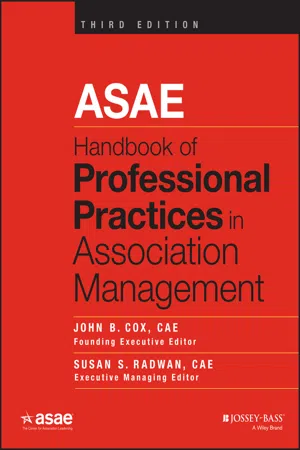
ASAE Handbook of Professional Practices in Association Management
- English
- ePUB (mobile friendly)
- Available on iOS & Android
ASAE Handbook of Professional Practices in Association Management
About This Book
A new edition of one of the flagship books for CAE preparation
The ASAE Handbook of Professional Practices in Association Management covers the core functions of association management at a high but practical level, making it a go-to resource for professionals who are leading and managing membership organizations and those preparing for the Certified Association Executive (CAE) credential. Now in its third edition, this core text in the ASAE association literature offers practical, experience-based insights, strategies, and techniques for managing every aspect of an association or membership organization.
Organized into 35 chapters and presenting information based on experience and proven research into the skills and knowledge required for successfully managing an organization of any size, this book covers governance and structure, leadership processes, management and administration (including finance and human resources), internal and external relations, programs and services, and much more. This new edition incorporates increased emphasis on the c-level judgment required of Certified Association Executives and CEO-aspirants, as well as more comprehensive coverage of essential functions such as planning.
- Covers the range of functions essential to managing an association
- Serves as a flagship handbook for CAE prep and is one of only five designated "CAE Core Resources"; new edition is applicable to prep beginning with the May 2015 CAE exam
- Information is relevant and applicable to students and professionals alike
- Edited by the founding editor of Professional Practices in Association Management and a CAE instructor with more than 30 years of experience in preparing CAEs
Put the experts to work for you with this essential resource—written by association professionals and experts with 300 years of cumulative experience!
Frequently asked questions
Information
Chapter One
A Prescription for a Successful CSE
What Does an Association Buy in a CSE?
Unique Position
- They evaluate and recommend strategy based on alignment to the mission.
- They collect, evaluate, analyze, and make meaning of relevant data.
- They determine positioning and present recommendations to the board.
- They recognize the role of and plan for an appropriately sequenced process that yields board and member support.
- They build effective work teams and ensure a productive work environment.
Board Partner
Changing CSE Role
Deliver Results
Table of contents
- Cover
- About the ASAE-Wiley Series
- Title Page
- Copyright
- Dedication
- Preface
- Acknowledgments
- Chapter One: A Prescription for a Successful CSE
- Chapter Two: Mission
- Chapter Three: Management
- Chapter Four: Managing the Complex Association Enterprise
- Chapter Five: Business Models and Economic Drivers
- Chapter Six: Identity and Branding
- Chapter Seven: Financial Management
- Chapter Eight: Globalization
- The Planning Continuum
- Chapter Nine: Environmental Scanning and Futures Analysis
- Chapter Ten: Environmental Scanning: A Chief Staff Executive's Perspective
- Chapter Eleven: Strategic Planning
- Chapter Twelve: High-Yield Tactical Planning
- Chapter Thirteen: Business Planning
- Governance: An Introduction
- Chapter Fourteen: Governance Structures, Process, and Culture
- Chapter Fifteen: Governance Relationships: The CSE and the Board
- Chapter Sixteen: Volunteer Leadership Development
- Chapter Seventeen: Component Relations
- Chapter Eighteen: Membership Recruitment and Retention
- Chapter Nineteen: Standard Setting
- Chapter Twenty: Legal Issues in Association Standard Setting, Certification and Accreditation Programs, and Codes of Ethics
- Chapter Twenty One: Developing and Managing Programs, Products, and Services
- Chapter Twenty Two: Fundraising and Development
- Chapter Twenty Three: Meeting and Event Management
- Chapter Twenty Four: Certification Principles
- Chapter Twenty Five: Affinity Programs
- Chapter Twenty Six: Optimizing Professional Development
- Chapter Twenty Seven: Strategic Leadership
- Chapter Twenty Eight: Diversity and Inclusion
- Chapter Twenty Nine: Human Resource Management
- Chapter Thirty: Integral Technology Management
- Chapter Thirty One: Legal Issues
- Chapter Thirty Two: Legal Liability Risk Management
- Chapter Thirty Three: Facility Management
- Chapter Thirty Four: Building Effective Industry Supplier Partnerships
- Chapter Thirty Five: Knowledge Management
- Chapter Thirty Six: Research and Evaluation
- Chapter Thirty Seven: Government Relations, Public Policy, and Coalition Building
- Chapter Thirty Eight: Marketing and Communications
- Chapter Thirty Nine: Publishing and Media
- Index
- End User License Agreement